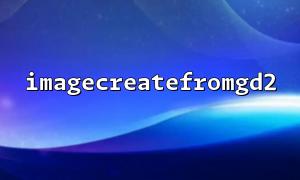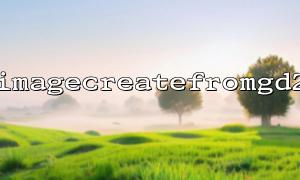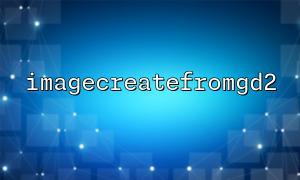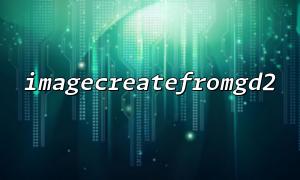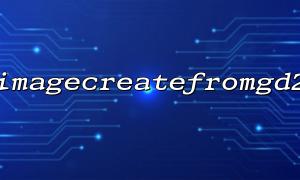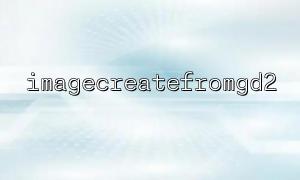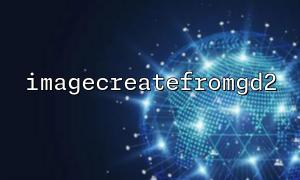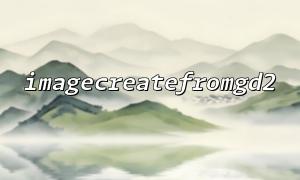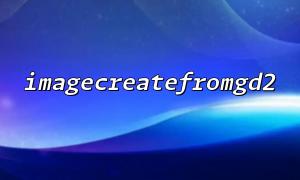Image processing is a common part of PHP programming, especially using the GD library for image creation and manipulation. When dealing with image format conversion, developers sometimes encounter the problem of using the imagecreatefromgd2() function to convert JPEG images to GD2 format. However, this approach is not recommended, mainly because of the following aspects:
The imagecreatefromgd2() function is used to load a GD2 format image file into memory. GD2 is a proprietary format for PHP, but it is not designed specifically to handle efficient JPEG conversions. Reading JPEG images into memory first and converting them to GD2 format results in significant performance overhead, especially when the image size is large. Each format conversion consumes a lot of memory and computing resources, thereby reducing the overall application response speed.
JPEG is a lossy compression format that reduces file size by discarding some image data. When converting JPEG to GD2 format and performing subsequent operations, the image quality will further degrade, especially if you have edited or converted the image multiple times. Each format conversion and modification adds distortion, resulting in the final output image quality that is much worse than the original JPEG image.
JPEG images usually have a smaller file size due to lossy compression than other formats such as PNG or BMP. When converting an image from JPEG to GD2 format, the file size is usually increased. Although the GD2 format is suffixed with .gd2 , it does not have the compression advantage of JPEG, which means you will face greater file storage needs, especially when dealing with large amounts of images.
Converting JPEG to GD2 format using the imagecreatefromgd2() function does not have obvious advantages. If you are just to perform basic operations on the image (such as cropping, resizing, adding watermarks, etc.), you can directly use imagecreatefromjpeg() to read the JPEG file to avoid unnecessary format conversion. Direct handling of JPEG formats not only improves the simplicity of the code, but also avoids unnecessary waste of resources.
The GD2 format has become somewhat outdated in the modern field of image processing. Compared with other mainstream image formats (such as PNG, JPEG, or WebP), the GD2 format has poor compatibility and limited support functions. Most image processing libraries and tools do not directly support the GD2 format, which means you may need additional steps to achieve cross-platform compatibility, increasing the complexity of system maintenance.
To avoid the above problems, developers can choose to use other more suitable image processing methods and formats. For example, use imagecreatefromjpeg() to process JPEG images directly, or use imagecreatefrompng() to process PNG images. If there are special needs, you can also consider converting images to other modern formats (such as WebP) to provide better image quality and compression.
Code example:
Assuming you want to process a JPEG image instead of converting it to GD2 format, here is a recommended code example:
<?php
// load JPEG image
$image = imagecreatefromjpeg('path_to_your_image.jpg');
// 对image进行操作(If resize)
$width = imagesx($image);
$height = imagesy($image);
$new_image = imagecreatetruecolor($width / 2, $height / 2);
imagecopyresized($new_image, $image, 0, 0, 0, 0, $width / 2, $height / 2, $width, $height);
// Save as a new file
imagejpeg($new_image, 'path_to_save_image.jpg');
// Free memory
imagedestroy($image);
imagedestroy($new_image);
?>
In this code, we directly use imagecreatefromjpeg() to load the JPEG image and perform a simple resizing operation. The entire process does not involve GD2 format conversion, which not only saves resources but also avoids quality losses caused by format conversion.
In summary, although imagecreatefromgd2() may have its application scenarios in some special cases, converting JPEG images to GD2 format is not recommended, especially for common image processing operations. Directly using the appropriate image processing function and choosing the right image format can not only improve performance, but also reduce quality loss and save storage space, thereby improving code efficiency and maintainability.

